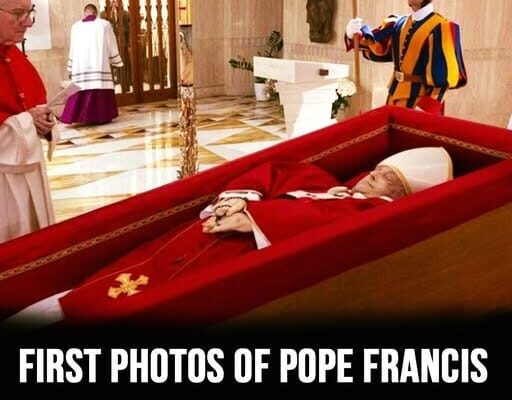A Final Testament: The Humble Farewell of Pope Francis

Every element in the images of Pope Francis lying motionless in his casket tells a tale, and there is much more to see than first glances.

It was immediately apparent that the late pope’s farewell would be different from all of his predecessors when the Vatican published the first sombre pictures of him in repose.

Pope Francis deviated from centuries of tradition in both minor and significant ways, staying true to the modest and reform-minded spirit he embodied throughout his pontificate.

His choice to forgo luxury in favour of simplicity was well thought out and spoke to his core beliefs, which were modesty, compassion for the underprivileged, and a rejection of excess.

The beloved Pope, revered around the world, spent his final weeks bravely battling pneumonia. On Monday, at the age of 88, he passed away peacefully following a massive stroke that led to irreversible heart failure.
Despite his declining health, those closest to him shared that he remained mentally sharp and spiritually serene until the very end. Surrounded by his devoted family and trusted medical team, he took his final breath in quiet dignity within the walls of the Vatican.

On Tuesday, the Vatican released poignant images of Pope Francis’s remains lying in state within a modestly adorned room of the Apostolic Palace—a final tribute to a life of humility and devotion.
Draped in striking red liturgical vestments—colors traditionally associated with martyrdom and the blood of Christ—he was honored not only as the Bishop of Rome but as a lifelong servant who embodied sacrifice, compassion, and unwavering dedication to the Church and its people.

Gently nestled between his folded hands was a rosary—an enduring symbol of his deep devotion to the Virgin Mary and a sacred tool he often encouraged the faithful to embrace in prayer.
Accompanying him in the coffin were several cherished and symbolic items: his crozier, the shepherd’s staff that reflected his pastoral role and guidance, and his mitre, the ceremonial headpiece worn by popes and bishops, signifying his sacred duty and spiritual authority throughout a lifetime of service.

The crozier, a profound symbol of the pope’s role as the Good Shepherd, speaks to his compassionate and wise leadership in guiding the faithful with care and insight.
Alongside it, a pair of Vatican coins minted during his pontificate were carefully placed in the casket. This age-old tradition serves as both a spiritual offering and a lasting testament to his time as the earthly shepherd of the Church.
Among the most significant items is the rogito, a sealed Latin document that chronicles the pivotal moments, achievements, and milestones of his papacy. This historical record, enclosed in a metal tube, is placed within the coffin as a lasting tribute to his legacy—preserving his story for generations to come.

Francis wore the Fisherman’s Ring on his right hand, a symbol of his papal authority, yet, in keeping with tradition, it was broken before his burial. Once used to seal papal documents, the ring is ceremoniously destroyed upon the death of a pope, marking the end of his earthly power and protecting against any potential misuse.
The breaking of the ring held profound meaning for Francis, who often humbly described himself as “a sinner whom the Lord has looked upon.” It was a poignant act, symbolizing the restoration of his soul to God, and reflecting the deep humility that defined his papacy.
Perhaps the most striking departure from tradition was the design of his coffin. Francis had long expressed a desire for simplicity over the ornate, preferring a single wooden casket over the customary three-tiered arrangement of oak, lead, and cypress. The chosen coffin, crafted from unadorned walnut and lined with zinc, was a testament to his personal values—humble, unadorned, and deeply spiritual. From the beginning of his papacy, he favored modest white robes, plain black shoes, and a simple room at the Casa Santa Marta, turning away from opulence and grandeur.
In this final decision, as in his life, Francis sought to prioritize spiritual substance over material splendor. By choosing simplicity, he wasn’t rejecting the Church’s rich history; rather, he was guiding it into a new era, one that emphasized the core Gospel values he so fervently preached: justice, mercy, inclusivity, and love—values that transcended the trappings of spectacle.
The casket was watched over by the Swiss Guard and Vatican officials, who paid their respects in a solemn, intimate atmosphere – a private farewell for a pope who had always valued human connection over formality.
The contents of Pope Francis’s casket continue to speak quietly but forcefully of a life lived with conviction, a faith practiced with humility, and a mission carried out with steadfast compassion as preparations for the public ceremonies and final burial get underway.
His journey to serve the last, the least, and the lost is a reflection of the one he took every day.



